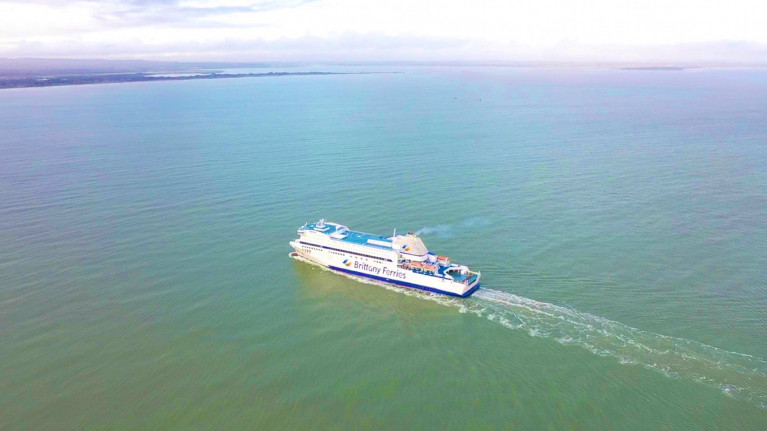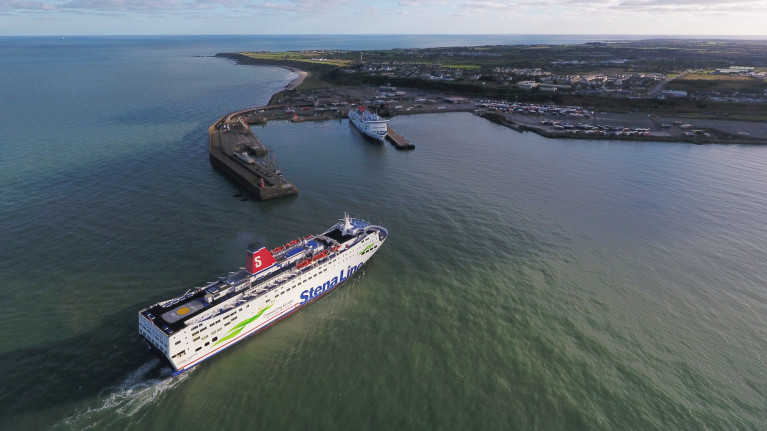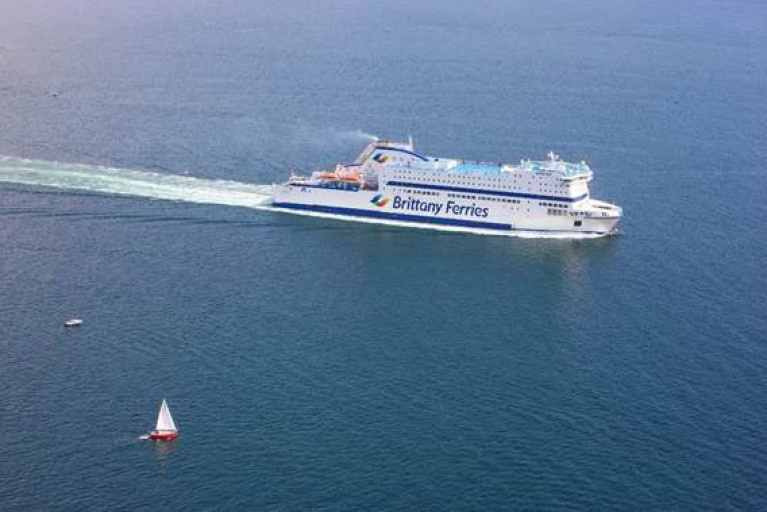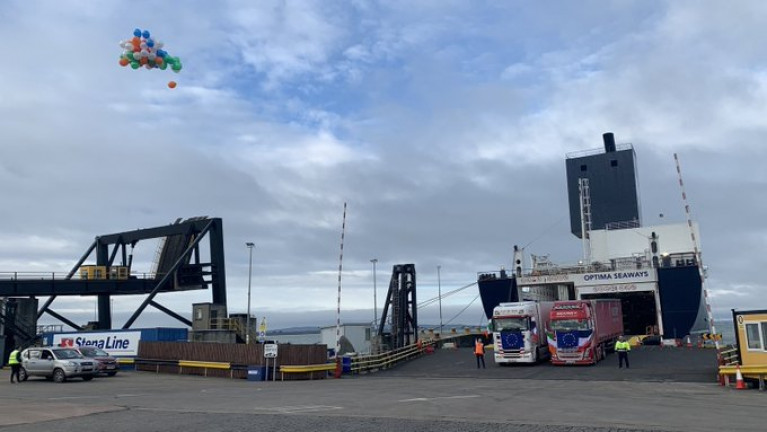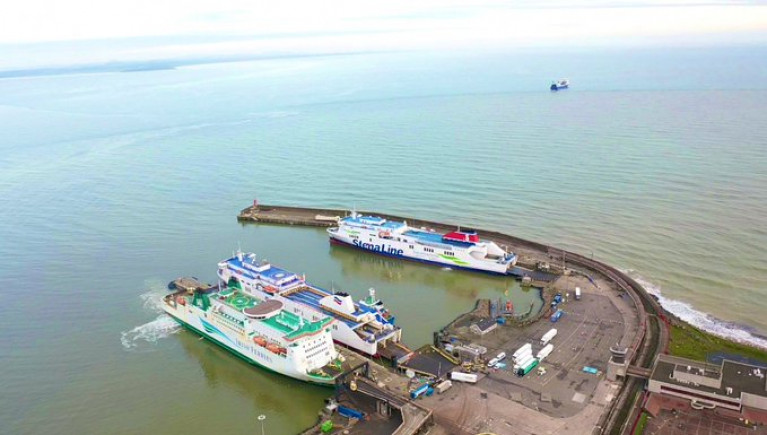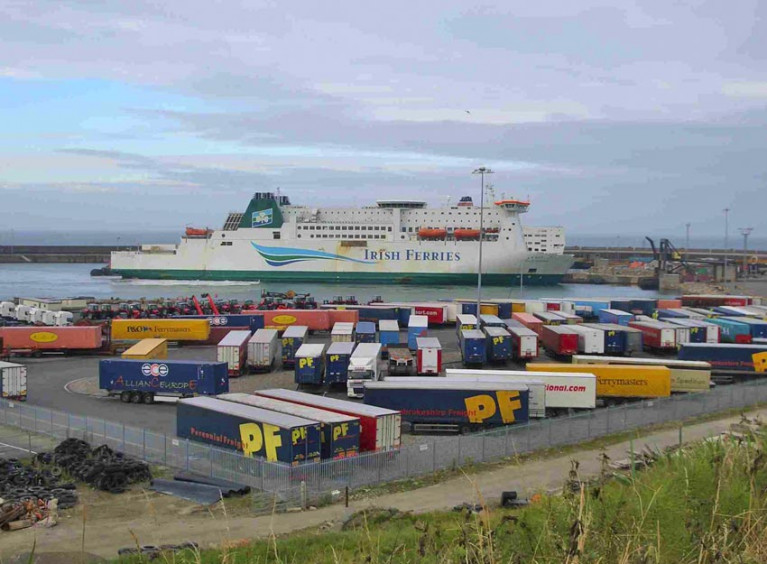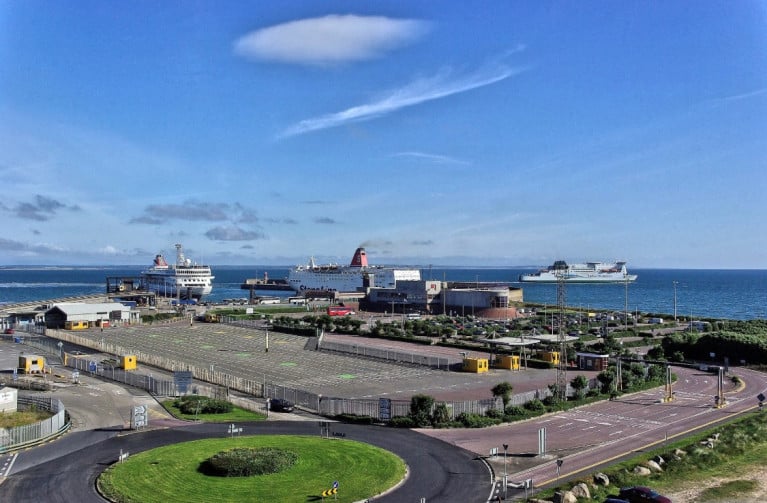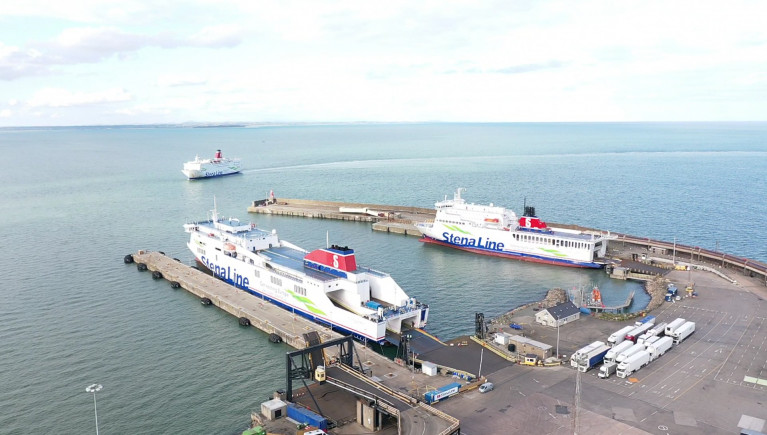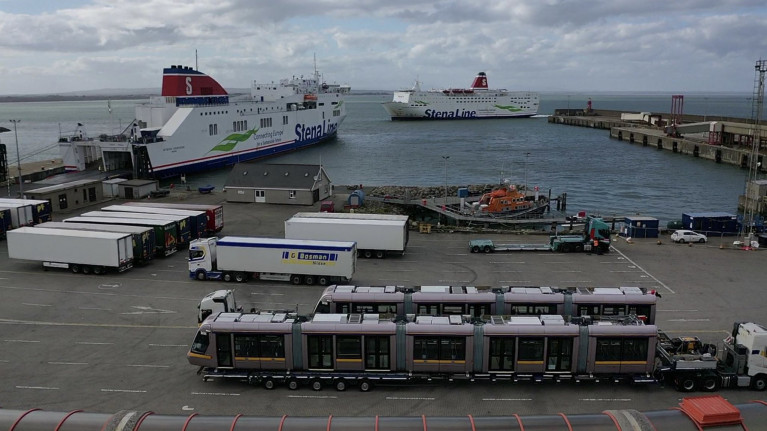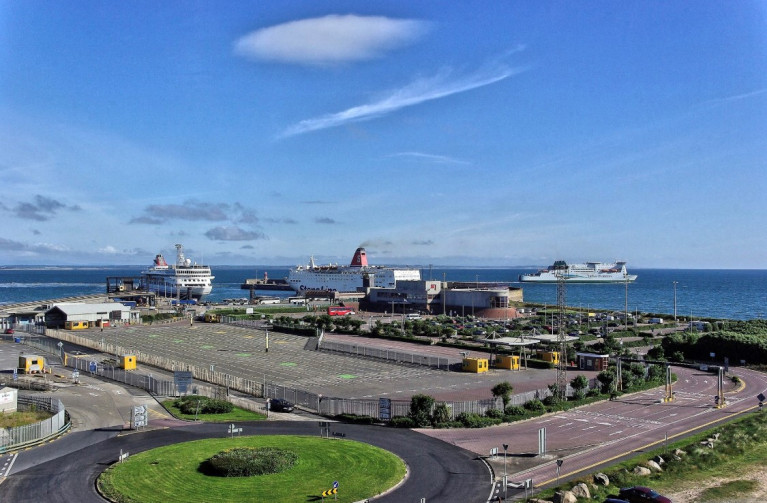Displaying items by tag: Rosslare Europort
Brittany Ferries New Four Freight Route Rotation Completes first Circuit in Rosslare Europort
Brittany Ferries this afternoon marked its first completion of operating the new four 'freight' route network of Ireland-France links that began running from Rosslare Europort on this day last week, writes Jehan Ashmore.
The Armorique which launched the 'Brexit-bypass' routes last Thursday, was to increase much needed freight vehicle space on direct ro-ro services to and from mainland Europe. This was also a first for the operator by linking Wexford and Brittany via St. Malo.
Last night the ferry had sailed from Roscoff overnight and arrived back to Rosslare this afternoon and on scheduled (1400) despite the weather.
Irish hauliers and other customers can avoid the UK landbridge and associated impact on EU/Brexit border trade with Brittany Ferries enhanced choice of four routes: they are Roscoff-St.Malo, Rosslare-Roscoff and Cork-St. Malo and Cork-Roscoff. For full rotation see earlier report.
Armorique will load freight trucks and drivers before the whole operation begins again with the cruiseferry repeating the rotation of routes linking Wexford, Brittany and Munster (as also reported). The sailing starts at 20.00hrs tonight and arrives in St. Malo the next day at 17.10.
In addition the Breton operator has more freight routes as this month a Rosslare-Cherbourg service was introduced complimenting last year's opening of the Rosslare-Bilbao route in northern Spain.
DFDS, operator of the new route to Dunkirk, using a trio of ferries among them the chartered Drotten vacated the linkspan at Rosslare's outer pier to where Armorique arrived this afternoon.
Astern of the French flagged ferry was the inbound Stena Estrid which was pressed into service on the route from Cherbourg, having been redeployed in recent weeks from the Dublin-Holyhead route.
Taking over these Irish Sea sailings saw Stena Horizon step in, the ropax was the original ferry that inaugurated the Ireland-France service under the banner of Celtic Link Ferries. In 2014, the route along with the same ferry, then Celtic Horizon was acquired by the Swedish operator, which was a first for the company to have a direct Ireland-mainland Europe route.
While Brittany Ferries have considerably taken action with these new routes, they do not have any freight marketshare based out of Dublin Port from where Irish Ferries and most recently Stena Line added a service directly to Cherbourg.
The port in Normandy is now the busiest in terms of direct ro-ro operations linking France-Ireland with two routes and operated by the three ferry firms providing a total of four services.
The head of Rosslare Europort, said Wales should focus on having one ferry port in Pembrokeshire instead of two to run alongside the main Holyhead port, it has been claimed.
As BBC News reports, Glenn Carr, general manager at Rosslare Europort in Ireland, said the move would entice hauliers back to Welsh routes crossing the Irish Sea.
A month into new trading rules with the European Union, freight using Fishguard and Holyhead is "dramatically down".
Rosslare's January traffic to the UK was down 49% on January 2019.
However, its European freight was up 446% as that route allows them stay in the EU and avoid customs documentation.
Traditionally, lorries from Europe with goods for Irish customers have taken a short ferry route into the south east of England, driven across the UK and taken another short ferry to Ireland.
Holyhead, Fishguard and Pembroke Dock have all benefited from this traffic.
But since 1 January, lorry drivers taking that route have to go through two sets of border checks in and out of the UK.
For much more on this story click here.
Afloat adds the Fishguard-Rosslare route is currently operated by Stena Line whereas Pembroke-Rosslare is served by Irish Ferries.
Afloat adds the call echoes somewhat that to 1986 when given different circumstance, a short-lived joint service involving rival operators, Sealink British Ferries (successor Stena Line) and B&I Line (ICG acquired /Irish Ferries) together ran on a single route, Fishguard-Rosslare.
This arose following the failure of SBF to obtain a 'jumbo' ferry on their route, however following the closure of B&I's Pembroke Dock route, an arrangement led for their Innisfallen to operate alongside SBF's St. Brendan on the 'southern' corridor's slightly shorter sea crossing.
This 'temporary' arrangement was to facilitate peak-season demand, however Innisfallen was unavailable due to requirements elsewhere on the Irish State owned company's ferry route network. This forced SBF to charter Prince Laurent from another state operator, RMT based in Belgium.
More on this historic development Afloat will report on as in the 1987 season, St.Brendan returned fresh from refit but notably sporting a joint SBF/B&I Line livery.
Further Expansion By Brittany Ferries, Increases Rosslare's European Services to 32 Weekly
The Government's Operational Update review on trade a month after the post-Brexit transition ended, Afloat adds narrowly missed inclusion as yet another ferry development arose today, as Brittany Ferries announced new 'freight' routes increasing capacity directly to mainland Europe.
Glenn Carr, General Manager of Rosslare Europort welcomed the announcement by Brittany Ferries of a further weekly service each between the Co. Wexford port and St Malo and Roscoff, in Brittany, France.
As also reported today, the revived Roscoff route resumes service this Thursday, 4th February (this follows, Afloat adds the route's debut last year albeit also available for passengers).
The new services combined bring to 32 – sixteen in each direction – the number of weekly direct services across all shipping operators between Rosslare Europort and the European continent, establishing Rosslare as Ireland’s number one port for direct European services.
The first month of trading in 2021 has seen sensational results at Rosslare Europort. Despite the challenges of Covid 19 and the current difficulties with the UK post Brexit, overall Freight traffic at the port is 45% ahead when compared to the same period last year.
While UK traffic is down 49% for January, European Freight is up an incredible 446% year on year with unprecedented demand for the new direct services operating from Rosslare Europort to mainland Europe.
Commenting on the first month of trading for 2021, General Manager, Glenn Carr stated “We are absolutely delighted with how the market has reacted and supported our direct services from Rosslare to Europe, and welcome Brittany Ferries further commitment to the needs of Irish industry with this new service announced today.
The demand has been phenomenal for the new and expanded services from all of our operators, and these results prove the strategic importance and potential of the port to our customers, industry and our economy. Through the significant challenges with Covid and Brexit, great credit must go to all colleagues working at the port and our shipping lines who have provided exceptional frequency and capacity on the now 32 services a week between Rosslare and Europe. We will continue to work with shipping lines and Irish industry in identifying further opportunities to meet market demand, and ensure that we build on the work to-date at the port to maximise the role of Rosslare Europort for both the South-East and wider economy of Ireland.
These are very exciting times at Rosslare Europort with the increase in business, commencement of our €35 million Masterplan and our recent proposal to Government for the port to be further developed as the Off-Shore Wind Energy Hub for the country and I look forward to working with all stakeholders in achieving this.”
The new Brittany Ferries service is the latest boost in 2021 to direct services between Rosslare Europort and the Continent.
So far, we have seen:
- New six-times weekly DFDS Rosslare Europort to Dunkirk service commence
- Expansion of Stena Line Rosslare Europort to Cherbourg services from three services each way weekly to six services each way weekly
- Stena Line capacity further increased, with the new Stena Embla redeployed to the Rosslare to Cherbourg route since Thursday 14th January
- Brittany Ferries began its weekly each way service between Rosslare Europort and Cherbourg two months ahead of schedule, in addition to the operators ongoing twice weekly each way service between Rosslare and Bilbao.
- In addition as Afloat earlier reported, Brittany Ferries is to start a new weekly Rosslare to St Malo route
Ferry Freight Traffic in January Up 45% at Rosslare Europort & Freight to Europe Up 446% Year-on-Year
Ferry services running out of Rosslare Europort has reported a 45% jump in freight traffic during January compared to the same period last year.
UK traffic is down 49% for the month, but European freight is up by 446% year-on-year, with "unprecedented demand" for the new direct services which opened up since 1 January between Rosslare and the mainland continent.
Hauliers have been using the services between Rosslare and Dunkirk and Cherbourg in France to avoid the UK landbridge, now that the post-Brexit fallout means extra customs and other checks for traffic entering and exiting the EU.
Meanwhile, the new regime requiring hauliers leaving Ireland for France to produce evidence of a negative Covid-19 test result is reported to be going relatively smoothly.
The first pop-up test centres for commercial drivers only opened in Gorey and Dublin on Thursday, with further "drive-through" centres since opened in Cork and Shannon, and another for truckers due to open at Holmestown outside Wexford town in the coming days.
More here reports RTE News on this record traffic development at Ireland's closest port to mainland Europe.
Irish Port of Rosslare is Hoping to Benefit following Brexit
As BBC News reports, the Irish port of Rosslare (Europort) hopes Brexit will be good for it as increasing numbers of hauliers seek to avoid the UK land bridge as the UK prepares to leave the EU.
That is because of fears about (ferry-related) traffic delays at Holyhead in Wales and Dover in Kent.
Two hours before dawn it is dark at Rosslare port in County Wexford, as a roll-on roll-off (ro-ro) ferry arrives from Wales to dock.
First light brings more ships; some from Wales, others from France and twice weekly from Bilbao in Spain.
The port is busy as the trucks leave with their cargoes for destinations all over Ireland.
But the hope is that because of Brexit and increased paper work it will get even busier.
For further reading on the increasingly important role of the ro-ro ferryport click here.
Rosslare Europort Seeks New Harbour Master
Iarnród Éireann is inviting applications for the position of Harbour Master at Rosslare Europort.
The closing date is Friday 29 October for suitably qualified candidates for the job — which would involve overseeing the safe and efficient management Ireland’s second-busiest RO/RO and RO/PAX port, handling 15% of the market.
The successful candidate will also be at the centre of the the ports ambitious development plan, which is expected to see substantial investment in infrastructure and technology, handling capacity and safety system, as well as Brexit preparedness.
As reported earlier today on Afloat.ie, the port is currently in talks to host a new, near-daily direct RO/RO haulage ferry route to the continental mainland amid concerns over the future of the UK land bridge.
Those applying for the role must have a STCW II/2 Certificate of Competency as Master valid for service in the Irish Mercantile Marine and at least three years of seagoing experience as master or chief officer of a merchant vessel, or as a harbour master (or deputy) in a comparable port.
Knowledge of port/terminal operations, ISM, PMSC, ISPS and current Irish OHS legislation is also a must.
For a detailed job specification and how to apply, email [email protected] using the subject ‘Harbour Master Job Specification’.
Rosslare Europort In Discussion for New Direct 'Daily' Ferry Service to Continental Mainland
As Afloat reported today Rosslare Europort recently received a relief ferry to the port which is in advanced talks with a shipping company to start a direct ro-ro service to continental Europe.
The talks, writes The Irish Times, is from hauliers looking to avoid any post-Brexit congestion on the UK landbridge.
The southeast port, the closest Irish port to mainland Europe, is in discussions with a new shipping line to start a six-days-a-week service before the transition period ends on December 31st.
Concerns about possible congestion at the Port of Dover from next year has led to calls from the haulage industry to establish a frequent ferry service direct to northern continental Europe.
These calls have intensified with warnings from the UK government that there could be delays of two days with queues of 7,000 lorries in Dover in a scenario where the EU and UK fail to agree a trade agreement to reduce border checks once the transition period ends.
Much more can be read here on this development to establish another direct link to mainland Europe.
Ferry First As Scandinavian Fleetmate Joins Stena Operations Out of Rosslare Europort
Afloat highlights the above busy scene as a trio of ferries and all from the same operator gathered recently in Rosslare Europort, writes Jehan Ashmore.
Most notably among the Stena Line ferries was the arrival of Stena Vinga (on right) which for the first time arrived to the Co. Wexford port. The ropax vessel is serving in the role of Irish Sea winter relief ferry while on 'loan' from Stena's fleet based in Scandinavia.
According to the operator's timetable, the temporary replacement ferry (firstly standing in on the Rosslare-Cherbourg service ) is to remain operating on the Ireland-France connection until the route's routine ropax Stena Horizon returns on 28 October. This is to involve an inbound sailing from Normandy.
Normally Stena Vinga operates the Gothenburg-Frederikhavn route that links the west Swedish city (homeport headquarters of Stena Line) and the east Danish port. This route is only 15 minutes longer than the Rosslare-Fishguard route served by the veteran vessel Stena Europe which too ran in Scandinavia firstly for Sessan Line.
On this day last week Stena Vinga began Rosslare-Cherbourg sailings albeit with much reduced passenger and freight capacity though this does note pose an issue given it is a much quieter time of the year coupled with Covid-19 restrictions.
Stena Vinga's transfer to the Ireland-France connection had led to the continental route's Stena Horizon deployed to the Dublin-Holyhead route. This allowed the ropax to take over the roster of Stena Estrid the leadship of the new 'E' -Flexer series.
The newbuild built in China had only entered service in January is currently covering Belfast-Cairnryan crossings. This is to enable Stena Superfast VII dry-dock for annual maintanence at Harland & Wolff.
Stena Vinga replaced a previous relief ferry Stena Nordica which recently carried out such duties including its former routine route of Dublin-Holyhead and beforehand Belfast-Liverpool, a first for this ropax despite until then serving all of Stena's Irish Sea network.
Rosslare Europort Receives Dutch Ambassador to Explore Port's Potential
Rosslare Europort is where the Dutch Ambassador Adriaan Palm visited on Friday to see for himself plans that are being put in place for offshore wind energy as well as gauging the Wexford ferryport's viability in terms of handling imports and exports post-Brexit.
Particularly of interest to Ambassador Palm, writes Wexford People, is the work being undertaken by Dutch company Xellz, who have invested a significant amount of money in Rosslare in recent times in a bid to create an 'offshore wind energy hub' there.
'Basically I'm visiting today because I want to see with my own eyes what the prospects are for developing offshore wind energy here in Ireland,' he said. 'Obviously there's a big focus now on sustainability and there are new climate targets to be reached. We have to do more on these issues. I know there are very exciting plans for Rosslare and I came here because I wanted to hear them for myself. We want to co-operate and learn from each other on the topic of climate change and sustainable energy.'
The visit follows that of the Irish minister of State, Hildegarde Naughton with responsibility for international and road travel and logistics.
Investment of €30m at Rosslare Europort, As Planning Permission Submitted for Port Masterplan
Port authority Iarnród Éireann, operator of Rosslare Europort, is to undergo a major transformation as part of its Port Masterplan, as the authority is set to apply for planning permission next week.
The Masterplan, together with initiatives under the strategic plan for the (predominant ferry) port, will see over €30 million invested by Iarnród Éireann in Rosslare Europort over the next five years. It will ensure that Rosslare will be equipped with the capacity, facilities and technology to facilitate major growth for the benefit of the region and the wider national economy.
Major changes in the Europort, and the subject of planning permission will be
- New configuration of the port aligned to maximise future growth of the port and support regional and national development
- Significant new facilities and infrastructure to develop Rosslare Europort to its full potential as Irelands gateway port to the UK and Europe
- Design and develop a Sustainable, Seamless and Smart Port that will be best in class internationally
The development under the Masterplan will be completed over a number of phases over a five year timeframe to enable the port continue to operate all services and activity during construction.
Rosslare Europort is the closest port to the UK and mainland Europe and offers numerous daily/weekly direct (ro-ro ferry & freight) services to the UK, France and Spain.
As well as the port masterplan further substantial investment will also take place both at the port and the surrounding area with the following further developments being completed during the same timeframe.
1. Construction of the New N25 Rosslare Europort Access Road by TII and Wexford Co Council
2. Development of the Rosslare Europort Business Park by the Dutch company XELLZ targeting the future Offshore Wind Market
3. Construction of the future permanent extensive facilities to meet all customs and Brexit requirements for state agencies.at the Port making Rosslare the only port outside of Dublin with the required Border Inspection Post
The combined developments will see the largest ever investment in the port and surrounding area and will position Rosslare Europort to become the leading gateway for the country to the UK and Europe
Glenn Carr General Manger Rosslare Europort said “These are probably the most exciting times that the port has ever seen with transformational developments planned over the next few years. We will be making significant investment demonstrating our commitment and drive to grow Rosslare Europort and ensuring that we maximise its full potential both for the region and the overall country.
While we will have challenges in dealing with the current Covid and Brexit situation, I am extremely optimistic with the plans we now have in place for the development of the port and growing of the business well into the future, building on new business from Brittany Ferries earlier this year.
We also very much welcome the additional substantial investments that are being made with the new port access road by TII and Wexford Co Council, the new Brexit facilities for state agencies by the OPW, Revenue, Department of Transport, Depts of Agriculture, Justice and Health and the exciting proposed Rosslare Business Park Zone by XELLZ; All of these development along with our masterplan will greatly benefit not just the port but also the economic development of the region.
Finally I also strongly believe that Rosslare Europort is now the best positioned port to be the Offshore Wind Energy hub for Ireland in the future. No other port in the Republic has the potential land, capacity and connectivity available that is required, and I look forward to working with all of the key stakeholders in securing the support and invested needed to secure the delivery of this vital development for the country.”
Masterplan Rosslare
Rosslare Europort engaged Nicholas O’Dwyer (NOD), with specialist input from NIRAS, to prepare an infrastructure masterplan that will deliver a sustainable, seamless and smart port for the future growth at Rosslare Europort. The infrastructure Masterplan has been developed in line with the Strategic Plan for the port and addresses current limitations at the port and provides for the key future functional requirements to enable Rosslare Europort to grow and maximise its full potential as the gateway port from Ireland to Europe.
Key Objectives of Masterplan
- Create an innovative design for a sustainable, seamless and smart port of the future;
- Review the existing facilities and identify their respective capacities and establish what additional facilities are required;
- Maximise all available land to meet the future traffic for the port, with particular reference to trends in vessel sizes / types and new business opportunities such as off shore wind energy / containers ,bulk and additional direct services to Europe;
- Substantial increase in Trailer/Container , Trade cars, bulk and general cargo storage at the port;
- Configure the port to be aligned with future external road and land development connecting with the port;
- Implement a full digitisation programme to create Ireland’s smartest IT port.
- Provide adequate land for the construction of the permanent Border Inspection facility to meet full customs, security and immigration control requirements;
Improved traffic and operations efficiency and safety; - Extension of a longer Berth with a second double linkspan to accommodate large vessels of the future
Phases of Masterplan
A full detailed phasing plan has been developed to mitigate potential conflicts during construction from 2020-2024 to ensure there will be a fully functioning Port at all times.
Phase 1
With the overall Rosslare Europort area increasing in usable space from its existing area the first phase of construction was to carry out the installation of the new perimeter access road, new entrance roundabout, security fencing along the perimeter, new freight check in area and the central spine access road.
A large proportion of this phase of the construction can be developed without any impact on the existing Port operations as the construction is on the area adjoining the port facility.
The only anticipated impact on the Port will be the connection to the existing entrance roundabout and the removal of some buildings along the perimeter as well as some minor impact to the existing trailer storage area. The phase 1 will also include the construction of the main service runs which will be installed under the main access routes. Phase 1 would enable freight to access the Port along the new road and roundabout and check in at the new location
Phase 2
On completion of Phase 1 access for all freight will commence along the new access road, around to the western roundabout and entre the port through the new freight check in area. The Phase 2 works will include all the paving areas from the new central spine road to the northern quay including the areas for the bulk storage, export trailer area and trade car areas.
The completion of these paved areas will enable existing storage areas to be transferred to free up zones for future.
Phase 2 will be completed in sections to enable operations continue within the port.
Phase 3 This phase is the alteration around the main loading and unloading areas at the berths. It stretches from the terminal building to the berths in one direction and from the new roundabout to Berth 1 in the other direction.
It would likely involve a number of small sections to be completed in sequence so as to minimise the effect on operations. It would be beneficial to complete the infill of the old rail line and construction of the new maintenance building initially to free up space for the diversion of traffic for the subsequent sections. The critical areas to complete would likely be adjoining berths and sequencing of the movement of traffic. This could be further developed during detailed design stages.
Phase 4 This final phase would include the areas for the import trailer storage, upgrade to the passenger vehicle check in and completion of the secure fencing.
With the previous phases completed this will free up a large proportion of the trailer storage area for construction and only during the passenger vehicle area modifications would there be some minor impact on Port operations.


























